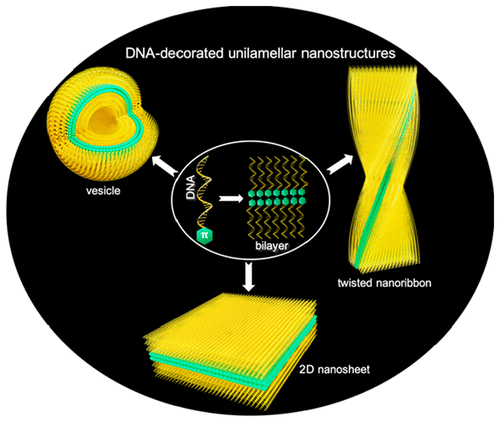当前位置:
X-MOL 学术
›
Acc. Chem. Res.
›
论文详情
Our official English website, www.x-mol.net, welcomes your
feedback! (Note: you will need to create a separate account there.)
DNA−π Amphiphiles: A Unique Building Block for the Crafting of DNA-Decorated Unilamellar Nanostructures
Accounts of Chemical Research ( IF 16.4 ) Pub Date : 2020-10-14 , DOI: 10.1021/acs.accounts.0c00492 Shine K. Albert 1 , Murali Golla 1 , Nthiyanandan Krishnan 1 , Devanathan Perumal 1 , Reji Varghese 1
Accounts of Chemical Research ( IF 16.4 ) Pub Date : 2020-10-14 , DOI: 10.1021/acs.accounts.0c00492 Shine K. Albert 1 , Murali Golla 1 , Nthiyanandan Krishnan 1 , Devanathan Perumal 1 , Reji Varghese 1
Affiliation

|
The unparalleled ability of DNA to recognize its complementary strand through Watson and Crick base pairing is one of the most reliable molecular recognition events found in natural systems. This highly specific sequence information encoded in DNA enables it to be a versatile building block for bottom-up self-assembly. Hence, the decoration of functional nanostructures with information-rich DNA is extremely important as this allows the integration of other functional molecules onto the surface of the nanostructures through DNA hybridization in a highly predictable manner. DNA amphiphiles are a class of molecular hybrids where a short hydrophilic DNA is conjugated to a hydrophobic moiety. Since DNA amphiphiles comprise DNA as the hydrophilic segment, their self-assembly in aqueous medium always results in the formation of nanostructures with shell made of DNA. This clearly suggests that self-assembly of DNA amphiphiles is a straightforward strategy for the ultradense decoration of a nanostructure with DNA. However, initial attempts toward the design of DNA amphiphiles were primarily focused on long flexible hydrocarbon chains as the hydrophobic moiety, and it has been demonstrated in several examples that they typically self-assemble into DNA-decorated micelles (spherical or cylindrical). Hence, molecular level control over the self-assembly of DNA amphiphiles and achieving diverse morphologies was extremely challenging and unrealized until recently.
中文翻译:

DNA-π两亲物:DNA装饰的单层纳米结构的独特构建基块
DNA通过Watson和Crick碱基配对识别互补链的无与伦比的能力是自然系统中发现的最可靠的分子识别事件之一。DNA中编码的这种高度特异性的序列信息使它成为自下而上自组装的多功能构建基块。因此,用信息丰富的DNA修饰功能纳米结构非常重要,因为这允许通过高度可预测的方式通过DNA杂交将其他功能分子整合到纳米结构的表面。DNA两亲物是一类分子杂化物,其中短的亲水性DNA与疏水部分缀合。由于DNA两亲物包含DNA作为亲水链段,它们在水介质中的自组装总是导致带有由DNA制成的壳的纳米结构的形成。这清楚地表明,DNA两亲物的自组装是用DNA超密集装饰纳米结构的直接策略。然而,设计DNA两亲物的最初尝试主要集中在长的柔性烃链上作为疏水部分,并且在几个实例中已证明它们通常自组装成DNA装饰的胶束(球形或圆柱形)。因此,对DNA两亲物的自组装和实现多种形态的分子水平控制是极富挑战性的,直到最近才实现。这清楚地表明,DNA两亲物的自组装是用DNA超密集装饰纳米结构的直接策略。然而,设计DNA两亲物的最初尝试主要集中在长的柔性烃链上作为疏水部分,并且在几个实例中已证明它们通常自组装成DNA装饰的胶束(球形或圆柱形)。因此,对DNA两亲物的自组装和实现多种形态的分子水平控制是极富挑战性的,直到最近才实现。这清楚地表明,DNA两亲物的自组装是用DNA超密集装饰纳米结构的直接策略。然而,设计DNA两亲物的最初尝试主要集中在长的柔性烃链上作为疏水部分,并且在几个实例中已证明它们通常自组装成DNA装饰的胶束(球形或圆柱形)。因此,对DNA两亲物的自组装和实现多种形态的分子水平控制是极富挑战性的,直到最近才实现。并且已经在几个实例中证明了它们通常会自组装成DNA修饰的胶束(球形或圆柱形)。因此,对DNA两亲物的自组装和实现多种形态的分子水平控制是极富挑战性的,直到最近才实现。并且已经在几个实例中证明了它们通常会自组装成DNA修饰的胶束(球形或圆柱形)。因此,对DNA两亲物的自组装和实现多种形态的分子水平控制是极富挑战性的,直到最近才实现。
更新日期:2020-11-17
中文翻译:

DNA-π两亲物:DNA装饰的单层纳米结构的独特构建基块
DNA通过Watson和Crick碱基配对识别互补链的无与伦比的能力是自然系统中发现的最可靠的分子识别事件之一。DNA中编码的这种高度特异性的序列信息使它成为自下而上自组装的多功能构建基块。因此,用信息丰富的DNA修饰功能纳米结构非常重要,因为这允许通过高度可预测的方式通过DNA杂交将其他功能分子整合到纳米结构的表面。DNA两亲物是一类分子杂化物,其中短的亲水性DNA与疏水部分缀合。由于DNA两亲物包含DNA作为亲水链段,它们在水介质中的自组装总是导致带有由DNA制成的壳的纳米结构的形成。这清楚地表明,DNA两亲物的自组装是用DNA超密集装饰纳米结构的直接策略。然而,设计DNA两亲物的最初尝试主要集中在长的柔性烃链上作为疏水部分,并且在几个实例中已证明它们通常自组装成DNA装饰的胶束(球形或圆柱形)。因此,对DNA两亲物的自组装和实现多种形态的分子水平控制是极富挑战性的,直到最近才实现。这清楚地表明,DNA两亲物的自组装是用DNA超密集装饰纳米结构的直接策略。然而,设计DNA两亲物的最初尝试主要集中在长的柔性烃链上作为疏水部分,并且在几个实例中已证明它们通常自组装成DNA装饰的胶束(球形或圆柱形)。因此,对DNA两亲物的自组装和实现多种形态的分子水平控制是极富挑战性的,直到最近才实现。这清楚地表明,DNA两亲物的自组装是用DNA超密集装饰纳米结构的直接策略。然而,设计DNA两亲物的最初尝试主要集中在长的柔性烃链上作为疏水部分,并且在几个实例中已证明它们通常自组装成DNA装饰的胶束(球形或圆柱形)。因此,对DNA两亲物的自组装和实现多种形态的分子水平控制是极富挑战性的,直到最近才实现。并且已经在几个实例中证明了它们通常会自组装成DNA修饰的胶束(球形或圆柱形)。因此,对DNA两亲物的自组装和实现多种形态的分子水平控制是极富挑战性的,直到最近才实现。并且已经在几个实例中证明了它们通常会自组装成DNA修饰的胶束(球形或圆柱形)。因此,对DNA两亲物的自组装和实现多种形态的分子水平控制是极富挑战性的,直到最近才实现。











































 京公网安备 11010802027423号
京公网安备 11010802027423号